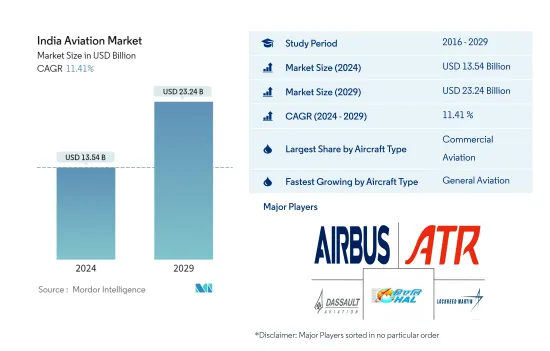Need help finding what you are looking for?
Contact Us
PUBLISHER: Mordor Intelligence | PRODUCT CODE: 1441493

PUBLISHER: Mordor Intelligence | PRODUCT CODE: 1441493
India Aviation - Market Share Analysis, Industry Trends & Statistics, Growth Forecasts (2024 - 2029)
PUBLISHED:
PAGES: 245 Pages
DELIVERY TIME: 2-3 business days
SELECT AN OPTION
The India Aviation Market size is estimated at USD 13.54 billion in 2024, and is expected to reach USD 23.24 billion by 2029, growing at a CAGR of 11.41% during the forecast period (2024-2029).

Key Highlights
- Largest Market by Aircraft Type - Commercial Aviation : Increasing air passenger traffic and its recovery to pre-pandemic levels, coupled with replacing existing aircraft with advanced sustainable aircraft, is driving the commercial aviation market.
- Largest Market by Sub-Aircraft Type - Passenger Aircraft : Strong economic growth and the increasing middle-class population are fuelling air passenger traffic growth and generating demand for passenger aircraft.
- Largest Market by Body Type - Narrowbody Aircraft : A fleet of narrowbody aircraft adds flexibility in terms of fleet management. It helps to reduce the airlines' operating costs, thereby resulting in the rapid adoption of this aircraft.
India Aviation Market Trends
Commercial Aviation is the largest Aircraft Type
- The civil and military aviation industry in India emerged as one of the fastest-growing industries in the country in the past few years. According to the Indian government, the commercial aviation sector contributed USD 30 billion to India's GDP in 2021. With this growth, the domestic aviation market is projected to rank third globally by 2024. As air traffic has been growing rapidly in the country as compared to the global average. The air fleet number may rise from the present 600 to 1,200 during 2024.
- The general aviation industry in India is considered a luxury for both business and private needs and strongly drives the country's economic growth. The surge of tourist traffic into India and the rising HNWIs have driven the growth of the general aviation sector in the country. Despite these driving factors, challenges in ease of doing business, complications with the tax structures, inadequate infrastructure, and complicated processes to obtain operating licenses have resulted in subdued growth of the business aviation market in India.
- India is a critical military aircraft market, as the country has been modernizing its aerial capabilities by procuring new aircraft and indigenously developing military aircraft to defend its borders from Pakistan and China. HAL is the largest manufacturer of aircraft and helicopters in India and has been producing BAE Hawk Trainers and Tejas LCA. It is also developing fifth-generation Advanced Medium Combat Aircraft under the Make in India initiative, with deliveries expected to start during the forecast period.
India Aviation Industry Overview
The India Aviation Market is fairly consolidated, with the top five companies occupying 96.43%. The major players in this market are Airbus SE, ATR, Dassault Aviation, Hindustan Aeronautics Limited and Lockheed Martin Corporation (sorted alphabetically).
Additional Benefits:
- The market estimate (ME) sheet in Excel format
- 3 months of analyst support
Product Code: 92734
TABLE OF CONTENTS
1 EXECUTIVE SUMMARY & KEY FINDINGS
2 REPORT OFFERS
3 INTRODUCTION
- 3.1 Study Assumptions & Market Definition
- 3.2 Scope of the Study
- 3.3 Research Methodology
4 KEY INDUSTRY TRENDS
- 4.1 Air Passenger Traffic
- 4.2 Air Transport Freight
- 4.3 Gross Domestic Product
- 4.4 Revenue Passenger Kilometers (RPK)
- 4.5 Inflation Rate
- 4.6 Active Fleet Data
- 4.7 Defense Spending
- 4.8 High-Net-Worth Individual (HNWI)
- 4.9 Regulatory Framework
- 4.10 Value Chain Analysis
5 MARKET SEGMENTATION
- 5.1 Aircraft Type
- 5.1.1 Commercial Aviation
- 5.1.1.1 By Sub Aircraft Type
- 5.1.1.1.1 Freighter Aircraft
- 5.1.1.1.2 Passenger Aircraft
- 5.1.1.1.2.1 By Body Type
- 5.1.1.1.2.1.1 Narrowbody Aircraft
- 5.1.1.1.2.1.2 Widebody Aircraft
- 5.1.2 General Aviation
- 5.1.2.1 By Sub Aircraft Type
- 5.1.2.1.1 Business Jets
- 5.1.2.1.1.1 By Body Type
- 5.1.2.1.1.1.1 Large Jet
- 5.1.2.1.1.1.2 Light Jet
- 5.1.2.1.1.1.3 Mid-Size Jet
- 5.1.2.1.2 Piston Fixed-Wing Aircraft
- 5.1.2.1.3 Others
- 5.1.3 Military Aviation
- 5.1.3.1 By Sub Aircraft Type
- 5.1.3.1.1 Fixed-Wing Aircraft
- 5.1.3.1.1.1 By Body Type
- 5.1.3.1.1.1.1 Multi-Role Aircraft
- 5.1.3.1.1.1.2 Training Aircraft
- 5.1.3.1.1.1.3 Transport Aircraft
- 5.1.3.1.1.1.4 Others
- 5.1.3.1.2 Rotorcraft
- 5.1.3.1.2.1 By Body Type
- 5.1.3.1.2.1.1 Multi-Mission Helicopter
- 5.1.3.1.2.1.2 Transport Helicopter
- 5.1.3.1.2.1.3 Others
- 5.1.1 Commercial Aviation
6 COMPETITIVE LANDSCAPE
- 6.1 Key Strategic Moves
- 6.2 Market Share Analysis
- 6.3 Company Landscape
- 6.4 Company Profiles
- 6.4.1 Airbus SE
- 6.4.2 ATR
- 6.4.3 Bombardier Inc.
- 6.4.4 Dassault Aviation
- 6.4.5 General Dynamics Corporation
- 6.4.6 Hindustan Aeronautics Limited
- 6.4.7 Leonardo S.p.A
- 6.4.8 Lockheed Martin Corporation
- 6.4.9 Textron Inc.
- 6.4.10 The Boeing Company
7 KEY STRATEGIC QUESTIONS FOR AVIATION CEOS
8 APPENDIX
- 8.1 Global Overview
- 8.1.1 Overview
- 8.1.2 Porter's Five Forces Framework
- 8.1.3 Global Value Chain Analysis
- 8.1.4 Market Dynamics (DROs)
- 8.2 Sources & References
- 8.3 List of Tables & Figures
- 8.4 Primary Insights
- 8.5 Data Pack
- 8.6 Glossary of Terms
Have a question?


SELECT AN OPTION
Have a question?


Questions? Please give us a call or visit the contact form.
